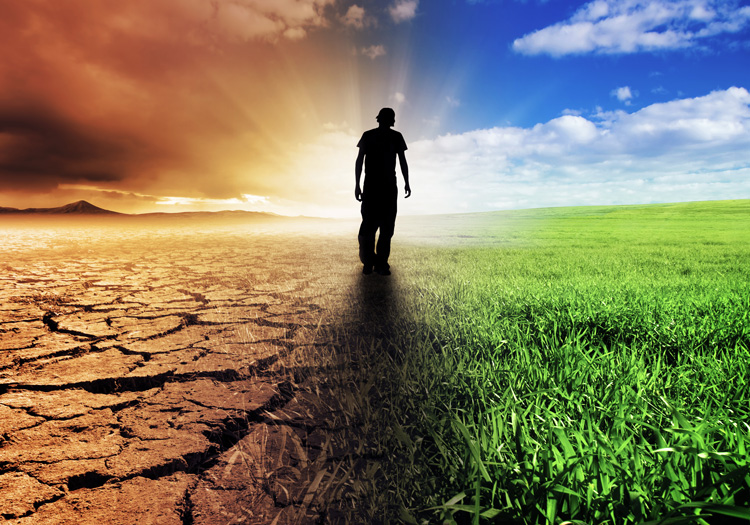Climate Action: A Catalyst for Change
In 2016, Category 4 Hurricane Matthew made landfall in Haiti: one of the world’s poorest countries, that has already endured decades of political upheaval, poverty, and a devastating earthquake. Matthew affected over 2 million people, leaving over 500 dead and displacing 175,000.
“We’ve seen in the last few years that these events are more frequent and more powerful because of climate change,” says Jerry Chandler, a surgeon and disaster medical specialist who leads Haiti’s disaster risk management agency, the Directorate of Civil Protection.
In August 2020, Tropical Storm Laura hit Haiti and its neighbor the Dominican Republic, claiming more lives and sending Haiti’s brigades of volunteers into action.
Haiti is strengthening its national systems for disaster response and risk reduction, though more resources are needed, says Chandler. Projects are underway to improve weather data and develop a national early warning system, and a national communication campaign is raising awareness of emergency procedures.
“People need to know exactly what they’re up against, so they can adjust and adapt their lives,” says Chandler.
Confronting COVID and Climate: Development Challenges like No Other
Like Haiti, countries around the world face mounting climate risk even as they deal with the coronavirus.
The still-unfolding pandemic has taken a heavy toll on global health and could push up to 100 million people into extreme poverty. The World Bank Group has fast tracked emergency assistance to 100 developing countries in response and could provide as much as $160 billion into 2021.
At the same time, the Bank Group remains committed to tackling climate change – another major threat, particularly for the world’s poorest and most vulnerable.
Just after the world came together for the landmark Paris Agreement on climate change, the Bank Group unveiled an ambitious Climate Change Action Plan to ramp up financial and technical support to developing countries to step up climate action.
The World Bank Group committed to increasing climate finance from 20% of lending in 2016 to 28% by 2020. This target was exceeded each year for the last three consecutive years. In total, over the duration of the Action Plan, the Bank Group has delivered over $83 billion in climate finance.
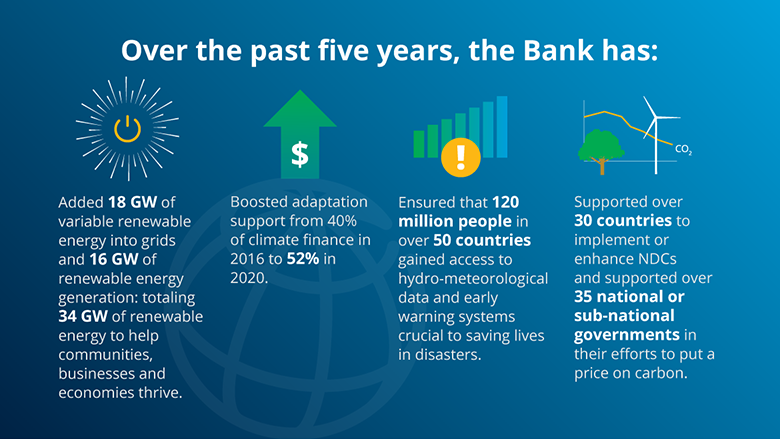
https://flo.uri.sh/visualisation/3443564/embed?auto=1A Flourish map
“If you look at what drives climate action in countries, and to a large extent within the World Bank, it is a recognition of the economic and social benefits of taking action now, rather than waiting,” says John Roome, the World Bank’s Sustainable Development Director for South Asia.
Here are five early takeaways – lessons learned from the Action Plan – that are fundamental to our efforts to help clients address climate change while also helping countries recover sustainably from the pandemic:
1. Integrating climate change in projects and strategies
As a result of the Action Plan, all new Bank projects are screened for climate risk. Climate change considerations are taken into account at every stage of project design and have been integrated into 100% of the Bank’s multi-year development strategies with developing country partners.
“This mainstreaming of climate into everything we do is what really changes everything,” says Stephane Hallegatte, Lead Economist for the World Bank’s Climate Change Group. “It puts climate-informed development on the table in a systematic manner and helps our clients unlock the opportunities of low-carbon, resilient development.”
Critically, the Bank’s support has branched out beyond sectors traditionally identified with climate action, such as energy, agriculture and environment, expanding the range of climate-smart development to projects that include enhancing digital development and climate resilience together in Bangladesh, integrating climate into macro fiscal budgeting and planning in the Philippines and improving energy and water efficiency into Egypt’s healthcare system.https://www.youtube.com/embed/MpS3x-Wmx1o?enablejsapi=1
2) Restoring landscapes and improving land use practices
With 4 billion people living in frequently water-stressed regions, the Bank Group made climate-smart land use a priority to boost food security and protect natural resources.
“We can see clearly that food systems in Africa in general are in jeopardy,” says Simeon Ehui, World Bank Sustainable Development Director for West and Central Africa. “We are talking about 277 million people suffering from undernourishment in Africa. And a key driver of that is climate change. We have to be able to do something about it.”
An increasing share of agriculture projects are “climate-smart”: increasing productivity and resilience while reducing greenhouse gas emissions. And solutions have been deployed at a large scale, bringing benefits to millions: in Maharashtra, India, 7 million farmers are being trained in soil fertility and water resources management; varietal crop selection and seed quality; and low-cost organic practices.
“There is no option but to take climate into account in terms of a recovery from COVID,” says Ayat Soliman, World Bank Director of Sustainable Development for the Middle East and North Africa, where projects are reviving oases and livelihoods and building resilience to droughts and floods.”.
“The recovery pattern is extremely important so that you do not have further exclusion or exacerbation of risk for certain groups that are already hard hit.”0:00 / 2:13
Video prepared by the Haiti Civil Protection Department as part of an extensive public communications campaign during this year’s hurricane season.
3. Protecting the vulnerable from climate shocks
“There is no doubt that the disruption caused by COVID-19 reinforces the importance of guarding against the environmental risks that have severe and systematic impacts across the economy, and that it provides an opportunity to reconsider what’s most important for the quality of life,” says Benoit Bosquet, World Bank Director for Sustainable Development in East Asia and Pacific.
Through the Action Plan, the Bank Group has helped countries reduce disaster risk through a combination of measures to build resilience in people, infrastructure, and economies – these are vital as climate impacts mount and can significantly reduce the number of deaths that occur. Preparedness in India and Bangladesh, for instance, ensured that millions were moved to safety before Super Cyclone Amphan arrived on their coasts in May.
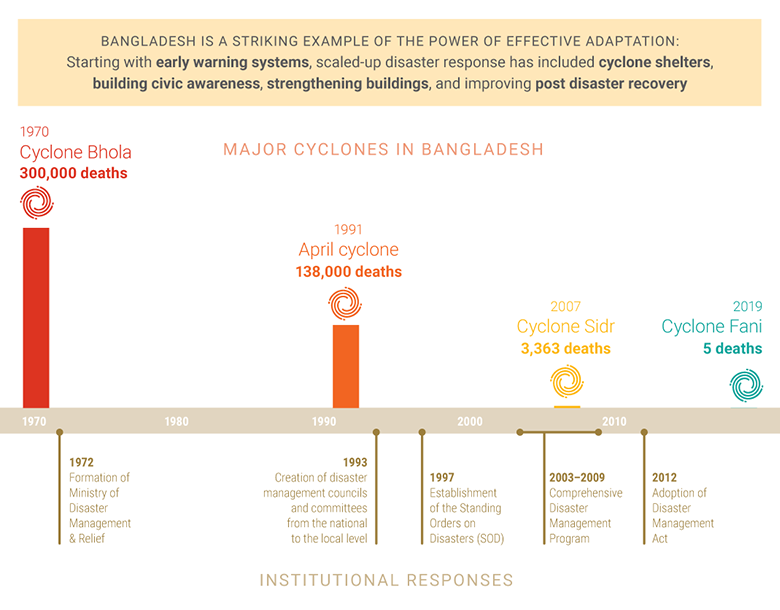
Key Policy Interventions in Bangladesh Contributed to Reduced Deaths from Climate Disaster.Photo: © Global Commission on Adaptation/World Resources Institute
In the Pacific islands, Tuvalu and Vanuatu quickly accessed emergency funds through a new instrument known as a Catastrophe Deferred Drawdown Option after being hit by cyclones earlier this year.
“A lot of the systems that we put in place to deal with, more often than not, climate events, were also the same kind of emergency response systems that were quite helpful for governments in organizing and responding to the pandemic,” says Anna Wellenstein, World Bank Sustainable Development Director for Latin America and the Caribbean.
These systems include “adaptive social protection”, or safety nets that can quickly expand in the event of a major shock, such as a cyclone or drought. In Mozambique, for example, an existing safety net expanded to cover 115,000 additional households affected by Cyclones Idai and Kenneth in 2019.
“The World Bank has helped low-income countries across the world develop their social safety nets and make them more shock-responsive, so they are better prepared for crises,” says Michal Rutkowski, World Bank Global Director for Social Protection and Jobs. “These kinds of systems can be scaled up during crises and adjusted to meet new needs.”
During the pandemic, countries with strong social protection systems have been able to ramp up support to their impacted populations faster and more effectively.
4. Encouraging the shift to low-carbon energy while expanding access
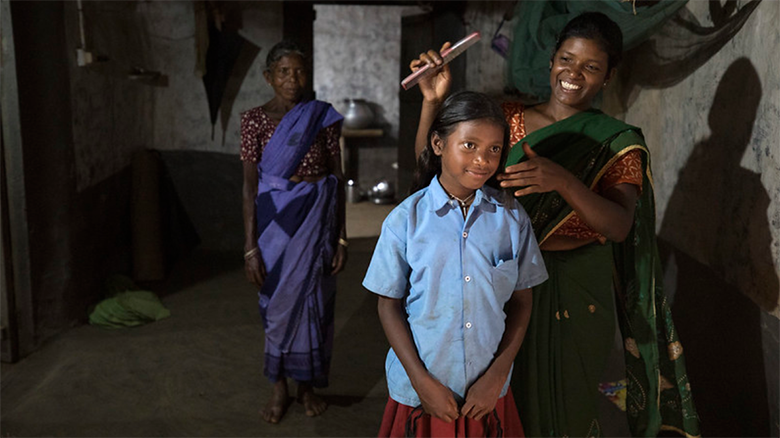
In one of India’s most remote villages, Sarita Asur, a subsistence farmer, talked about the day she switched on the light for the first time: “It was a very happy moment. It changed my family’s life.” With the help of a small firm backed by the Bank’s private sector-focused arm, IFC, her home is now outfitted with three LED bulbs that receive power from an 8-kilowatt grid.Photo: © Dominic Chavez/IFC
The Group prioritized investments in renewable energy and energy efficiency as key to helping clients reduce emissions. It backed some of the world’s biggest solar projects, joining the Climate Investment Funds to support the Noor concentrated solar plant in Morocco, one of the few in the world to use this pioneering technology to store solar energy. The Group also supported the BenBan solar park in Egypt, and the Ultra Mega Solar Park in India, which helps power the Delhi Metro roughly 800 km away.
“It’s critical to start understanding climate as an opportunity,” says IFC Director of Climate Business Alzbeta Klein. “We know from evidence and from past work that a lot of renewable technologies are providing a fair number of jobs. In the recovery from the pandemic, countries have an opportunity to support the jobs that need to be created for the lower carbon pathways of the future.”
Off-grid solar has reached millions of people, mainly in South Asia and Africa, and may become the main way 40% of Africans gain access to energy, says Riccardo Puliti, the World Bank’s Senior Director of Infrastructure in Sub-Saharan Africa.
The Group’s Lighting Global program has built an international off-grid market which now supports a $1 billion-a- year industry providing energy access to over 150 million people.
“We target a doubling of energy access across Africa by the end of this next decade to keep Africa as the world’s climate-friendly continent. Over the last four years, our projects have been bringing on stream about 1,000 MW of new green, climate-friendly power, through geo-thermal, solar, and hydro—and there is more to come” says Thomas O’Brien, Senior Advisor in the context of the Group’s Next Generation Africa Climate Business Plan.
5. Shifting to lower-carbon transportation
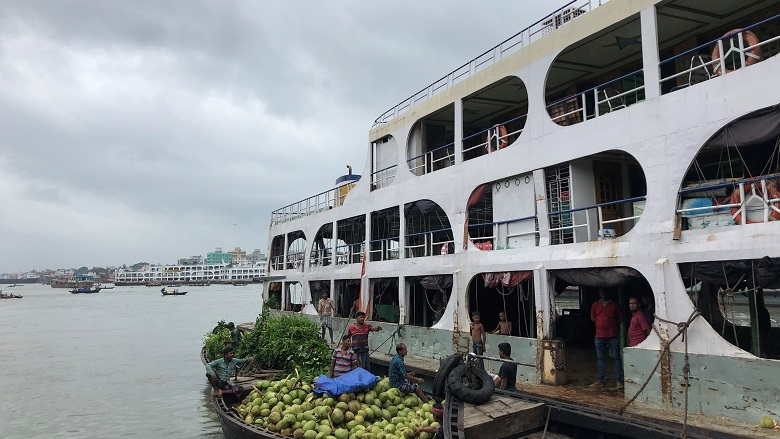
Bangladesh has developed a low-carbon strategy and business plan for its inland waterway transport sector, with support from the Bank’s NDC Support Facility. Photo: © Mehrin Mahbub/World Bank
With transport responsible for a quarter of energy-related greenhouse gas emissions globally, the Bank is supporting clients invest in public transit systems, shifting freight from roads to railways and, where possible, to waterways, which have the lowest emissions per ton kilometer of transport.
The Bank is backing a rail corridor dedicated to moving freight between the Indian megacities of Delhi and Kolkata and is looking to support inland waterways for moving freight and people across Bangladesh, India and Nepal, according toGuangzhe Chen, the World Bank’s South Asia Infrastructure Director.
In Latin America and the Caribbean, the revolution in battery technology is making battery powered electric buses viable, according to Franz R. Drees-Gross, World Bank Infrastructure Director for the region.
In Europe and Central Asia, where energy intensity is high, there has been an effort to shift freight from trucks to railways, make public and private buildings more energy efficient, and to add renewable energy while reducing coal, according to Lucio Monari, the World Bank Infrastructure Director for the region.
And as countries embark on cleaner energy pathways and transportation, they should think through how to ensure a just transition for fossil fuel-dependent communities. “In order to effect a transition which is going to be successful we will have to find ways of mitigating the impact on people who work in the coal economy,” saysRanjit Lamech, Infrastructure Director for the World Bank’s East Asia and Pacific Region.
These kinds of policies can also complement carbon pricing tools: as of 2020, 61 countries in the world have or are scheduled to implement efforts that will price carbon.0:00 / 0:50
Climate Change Action Plan 2.0
Results from the recently concluded Plan make clear the Group’s leadership on climate action. Looking ahead, our next Climate Change Action Plan (2020-2025), already underway, aims to boost support for countries to take ambitious climate action by increasing financing for adaptation and supporting increased systemic climate action at the country level.
Implementing this as countries also grapple with the economic consequences of COVID-19 means looking at interventions that can deliver short term objectives – such as jobs and economic growth – as well as longer terms ones like decarbonization and boosting adaptation and resilience, helping our clients shape a sustainable recovery.
Drawing from our technical expertise, operational know-how and financial resources – including through successfully delivering our first ever Climate Change Action Plan – we will expand our efforts, for instance going beyond traditional climate sectors and making sure that climate prior actions are core parts of the economic recovery from the pandemic. This is how we can deliver the critical systemic, economy-wide change for our clients and help set development pathways today that can unlock low-carbon, resilient benefits for decades to come.
“For those of us who have worked in development for years, it’s clear that climate change could unravel our most hard-won efforts”, says Bernice Van Bronkhorst, Global Director, Climate Change. “We are at a once-in-a-generation moment to help clients act on climate and in so doing also gain the benefits of cleaner air and water, healthier oceans, more resilient cities, and more sustainable food and agriculture systems. We are committed to getting this right.”


